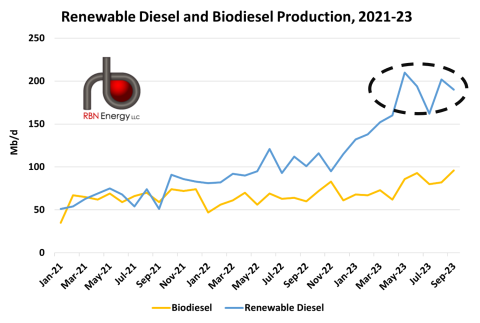Renewable diesel (RD) production has been surging this year, far surpassing blending mandates established by the Environmental Protection Agency (EPA). But there may be storm clouds on the horizon. The jump in RD production has led to excess generation of Renewable Identification Numbers (RINs), the tool used to ensure compliance with the Renewable Fuel Standard (RFS), impacting RD economics. With RD production set to move even higher in 2024 amid already-declining margins, it has left some to wonder how the market will come back into balance. In today’s RBN blog, we look at the growth in RD production, the resulting impact on RIN volumes and prices, and how things could shake out next year.
As we explained in Driver’s Seat, RD, like biodiesel, is a biomass-based fuel that can be burned in diesel engines or used as heating oil for homes. In distinguishing between those two similar-sounding diesel alternatives, there are unique aspects of RD that give it an edge over biodiesel as a substitute for petroleum-based ultra-low sulfur diesel (ULSD). Most important perhaps is that RD meets or exceeds the fuel specifications of ULSD, and is thus considered a “drop-in” replacement, whereas biodiesel (fatty acid methyl ester, or FAME) is typically limited to blends of between 5% (a diesel/biodiesel blend known as B5) and 20% (aka B20). In fact, unlike biodiesel, which has poor cold-flow properties and runs a risk of containing contaminants, RD generally has a higher cetane value (an octane-like measurement of diesel and diesel alternatives; see That’s the Good Stuff) than ULSD, promoting more complete combustion and higher engine efficiency, and has comparable cold-flow properties to petroleum-based diesel.
RINs are a feature of the federal RFS, which requires certain minimum volumes of biofuels to be blended into fuel sold in the U.S. The required minimum, known as the Renewable Volume Obligation (RVO), is determined each year by the EPA. A RIN is a virtual coupon that comes attached to each gallon of biofuel that gets produced. RINs come in different categories with different names. The D4 RIN, applies to bio-based diesel fuels made from soybeans and other bio-feedstocks, RD, biodiesel or sustainable aviation fuel (SAF). The RIN is detached when that gallon of biofuel is blended with conventional diesel for use as fuel. The blender then redeems the coupon by selling it to petroleum fuel suppliers that need to satisfy their RVOs. (Under the RFS, D5 RINs for advanced biofuels can also be used to count toward the EPA’s overall D6 RIN requirement. D4 RINs are a subset of D5 RINs. For further clarification, check out Baby, The RINs Must Fall.)
RD production (blue line in Figure 1) has been on a steady climb over the past three years, jumping from about 50 Mb/d in January 2021 to as high as 210 Mb/d in May 2023 and remaining around 200 Mb/d in the most recent data available (dashed black oval) as a number of new plants have started up this year.
Figure 1. Renewable Diesel and Biodiesel Production, 2021-23. Source: EIA
Join Backstage Pass to Read Full Article











